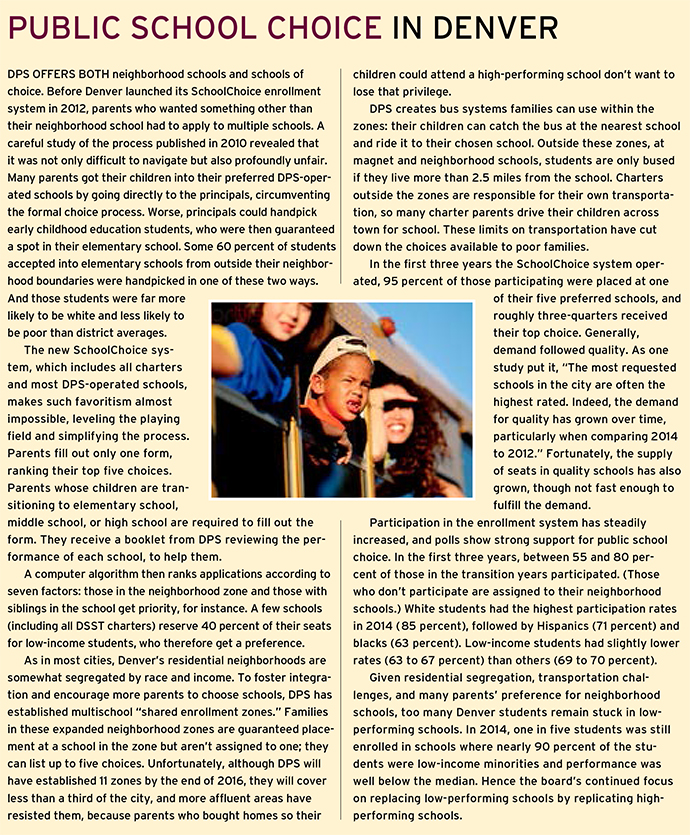
Some of the most dramatic gains in urban education have come from school districts using what’s known as a “portfolio strategy.” Under this approach, districts negotiate performance agreements with public schools—traditional, charter, and hybrid models. The arrangement affords school leaders substantial autonomy to handcraft their schools to fit the needs of their students. Districts give parents choices among the schools while working to replicate successful schools and replace failing ones.
Many doubt such a strategy is possible with an elected board, because closing schools and laying off teachers triggers fierce resistance. Most cities pursuing the portfolio strategy, including New Orleans, Washington, D.C., and Camden, New Jersey, have done so with insulation from local electoral politics. In New Orleans, the state board of education and its Recovery School District (RSD) oversee most of the schools; Congress created the appointed D.C. Public Charter School Board; and in Camden the state is in charge.
All of which explains why reformers are paying close attention to Denver, Colorado. With an elected board, Denver Public Schools (DPS) has embraced charter schools and created innovation schools, which it treats somewhat like charters. Since 2005 it has closed or replaced 48 schools and opened more than 70, the majority of them charters. In 2010 it signed a Collaboration Compact committing to equitable funding and a common enrollment system for charters and traditional schools, plus replication of the most effective schools, whether charter or traditional.
Of the 223 DPS schools today, 55 are charters, which educate 18 percent of its students, and 38 are innovation schools, which educate 19 percent (see Figure 1). Soon DPS will take the next step, creating an Innovation Zone with an independent, nonprofit board, which will negotiate a performance contract with the district. Beginning with four innovation schools but able to expand, the zone could for the first time give district schools the autonomy charters enjoy.
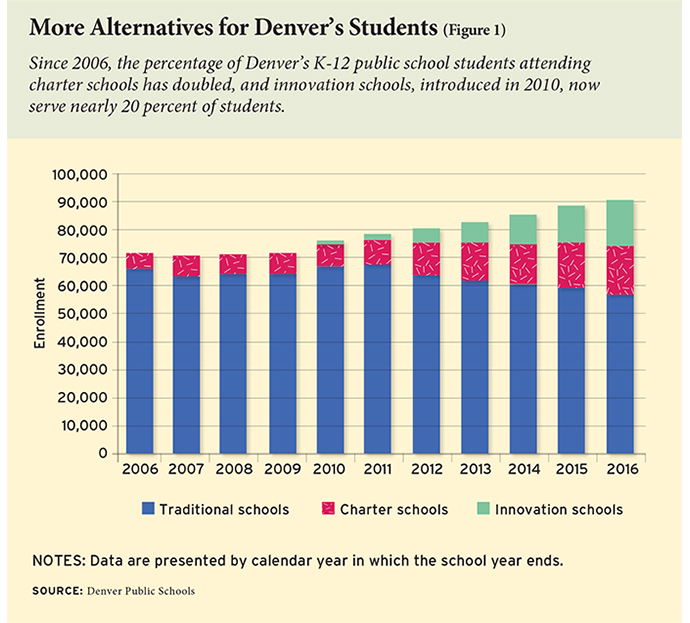
For years, Denver’s reforms stirred controversy. When the board closed or replaced failing schools, protests erupted and board meetings dragged into the wee hours. During most of current superintendent Tom Boasberg’s first five years, he had only a 4–3 majority on the board. But the strategy has produced steady results: a decade ago, Denver had the lowest rates of academic growth among Colorado’s medium and large districts; for the last three years it has ranked at the top. Voters have responded by electing a board with a 7‒0 majority for reform.
Denver’s U-Turn
In 2005, DPS was floundering. Out of 98,000 seats, 31,000 were empty, and many school buildings were half full. Almost 16,000 Denver students had left DPS for private or suburban schools. A financial crisis loomed, in the form of pension contributions the district could not afford. When Superintendent Jerry Wartgow retired in 2005, the Denver Board of Education chose Michael Bennet, chief of staff for then mayor John Hickenlooper, to replace him. Bennet had no background in public education, but he had spent time turning around failing companies for a local investment firm.
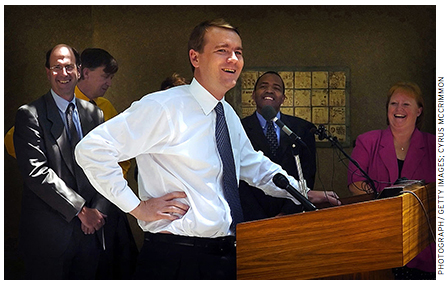
A few reforms were already underway: Wartgow had negotiated a pay-for-performance system, called ProComp, with the teachers union, and he was reconstituting 13 elementary and middle schools. He had built support for DPS among business and community leaders. Several foundations were pushing for reform; African American and Latino leaders were engaged; and a 27-member Commission on Secondary School Reform, appointed by the school board, had submitted reform recommendations.
“There was a consensus that we had to do something,” says David Greenberg, who founded the Denver School of Science and Technology (DSST), which has since grown into the city’s most successful charter network. “But there was no consensus about what.”
Bennet knew he had to lure students back from other districts to stave off financial ruin. He considered the charter sector, which in 2005 had only 17 schools and served just 7 percent of the district’s students, too small to make a difference. He and the board initially chose to centralize control over curriculum, budgets, hiring, and almost everything else.
DPS was so dysfunctional, Bennet concluded, that he could not fix it without significant outside pressure. So he asked several foundation leaders to create an organization of civic leaders, chaired by two former mayors, to push for change and support the board when it promoted reform. They called the initiative A+ Denver, and it has championed the portfolio strategy, along with the Piton, Donnell-Kay, and Gates Family foundations.
In April 2007, a study by the Piton Foundation and the Rocky Mountain News revealed just how many students were leaving Denver for private schools and other districts. Bennet and the board responded with a call for dramatic change. “It is hard to admit,” they wrote, “but it is abundantly clear that we will fail the vast majority of children in Denver if we try to run our schools the same old way.” The district should “no longer function as a one-size-fits-all, centralized, industrial age enterprise making choices that schools, principals, teachers, and most, most important, parents are in a much better position to make for themselves.” Instead, it should “function more like a partner, building capacity and leadership at the school level and serving as an incubator for innovation.”
To help that process along, Bennet in 2008 shifted from traditional budgeting to a weighted, student-based budgeting system, under which about 56 percent of operating money follows students to their chosen schools (see sidebar). This increased competitive pressures on schools, because losing students meant losing money.
DPS also unveiled a School Performance Framework (SPF) that measured test scores, academic growth, student engagement, enrollment rates, and parental satisfaction. Using the Colorado Growth Model, it gave far more weight to academic growth than to current proficiency levels—triple the weight at the elementary level, double in secondary schools. Every school wound up with a score that summarized its performance, and charter schools quickly dominated the top-ten lists.
That spring the Rocky Mountain News splashed a full-page photo across its cover of the first graduating class from DSST, a charter school. Every one of its graduates had gained admission to college—the first time that had happened in a Denver school with many low-income students. Bill Kurtz, founding head of the school, believes that was a turning point. “When I came to Denver,” he says, “there was a mindset that not all kids can go to college, that your income and race would determine that.” But DSST’s accomplishments gave “the leadership of the district an understanding that what was thought impossible was possible.”
With the SPF in place to ensure accountability and charters proving that autonomy worked, Bennet and the board switched to a strategy they called “Performance Empowerment.” It endorsed moving more decisionmaking to the school level as principals proved their schools could perform.
They also decided to replicate DSST and other strong charters as fast as they could. Given the teachers union’s opposition, however, they didn’t trumpet the strategy. They kept their message simple: they would replace failing schools with better schools, regardless of their type.
An astute politician, Bennet also worked with two community organizations, soliciting their views and support. The group Together Colorado is a multiracial, multifaith coalition of more than 60 congregations and clergy, schools, and youth committees, affiliated with the national PICO network. Padres & Jóvenes Unidos is an organization of Latino activists that dates to the 1970s. Both work on a variety of issues but were instrumental in supporting Bennet’s reforms.
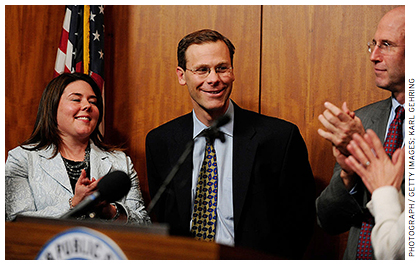
“They really inoculated the district from having the kind of blowback that other districts have had from low-income communities of color,” says Van Schoales, CEO of A+ Denver. “It made it harder for the traditional factions—they lost some of the potential opposition to a lot of these reforms.”
It is easier to open and close schools when your student population is rising, and Denver’s was growing rapidly. DPS enrollment has increased 25 percent since 2005, driven by population growth, residential development on a closed airport and military base, expanded preschool programs (available to most four-year-olds and a few three-year-olds), and students returning from neighboring districts. In October 2015, DPS reported 91,429 students, up from 73,018 in 2005. (Note that, unlike those in Figure 1, these numbers include pre-kindergarten students.) Just over 56 percent are Hispanic; 23 percent are white; 14 percent are African American; 70 percent qualify for free or reduced-price lunch; and 38 percent are English language learners.
In early 2009, Governor Bill Ritter appointed Bennet to fill the U.S. Senate seat of Ken Salazar, the new secretary of the interior. Bennet urged board members to appoint his deputy and lifelong friend, Tom Boasberg, as superintendent, and they quickly agreed. Though Boasberg embraced the portfolio strategy, he also eschewed the words, preferring “an intentional strategy to say we are going to focus on great schools as opposed to political arguments about governance structures.”
Winning the Political Battle
In 2009, the district opened eight new schools and planned to open seven more for 2010. By this time the Denver Classroom Teachers Association was on alert. It backed a slate of board candidates that fall and won a majority of open seats, and one of its supporters prepared to take the board presidency. But the union had been a bit careless in vetting Nate Easley, an African American who grew up in Denver but had recently returned from Washington, D.C., to help lead the Denver Scholarship Foundation. Easley surprised everyone by embracing reform, and—being the swing vote—he was elected board president. Suddenly the union’s 4‒3 board majority had reversed, triggering a bitter divide that lasted for four years.
Tensions came to a head in the fall of 2010, when the board decided to replace a group of schools in the far northeast area of the city, including Montbello High School, with 10 innovation schools and a handful of charters. “That was when the controversy really got enormous,” says Mary Seawell, a board member at the time. “The scale and scope was like nothing the district had ever done before, and there were so many schools impacted. It was a highly charged, emotional political process,” with people screaming at community and board meetings, which often lasted until well past midnight.
The antireform block warned Easley that if he voted for the replacement strategy, they would recall him. He had been a straight-A student at Montbello High, but at Colorado State College he had tested into remedial classes—a devastating blow, as he describes it. So he understood exactly how Montbello was failing its students. He voted for the changes, and his opponents launched a recall effort—but failed to secure the required number of signatures.
In the fall 2011 elections, reformers managed to preserve their 4‒3 majority. Two years later, Democrats for Education Reform and its allies raised significant money and recruited a former lieutenant governor, a former city council president, and a former chairman of the Denver Democratic Party to run. Finally, they broke the logjam. With six reformers, the new board initiated a turnaround strategy in southwest Denver and approved another major expansion of DSST, which will educate one-quarter of all middle and high schoolers by 2025. In 2015, a reformer won the final seat.
Delivering Results
The reformers won in part because they had more money and better-known candidates, and in part because their approach has yielded results. In 2005‒06, 11.1 percent of DPS students dropped out each year, and in 2006‒07 less than 39 percent graduated on time. By 2014‒15, only 4.5 percent dropped out each year, while 65 percent graduated on time, including 72 percent of those who entered DPS high schools and stayed for four years. (All data include charter schools.)
In the decade ending in 2014, the percentage of students scoring at or above grade level in reading, writing, and math increased from 33 to 48, far faster than the state average (see Figure 2). In 2015, Colorado switched to the PARCC tests, so comparisons to previous years are no longer possible. But Denver schools appear to have adjusted far better to the more demanding, Common Core‒aligned PARCC tests than schools in the rest of the state. In 2014, Denver students outperformed only 16.7 percent of Colorado students on the elementary English language arts test, but in 2015 they outperformed 42.4 percent of their peers statewide. In elementary math, Denver jumped from the 19th percentile to the 49th, almost reaching the state median. Middle schools were even stronger: in English, they jumped from outperforming 17.5 to 51.4 percent of their peers, and in math from the 39th to the 65th percentile, far above the state median. These results should be interpreted cautiously, however, as roughly 1 in 10 Colorado students opted out of the spring 2015 PARCC test.
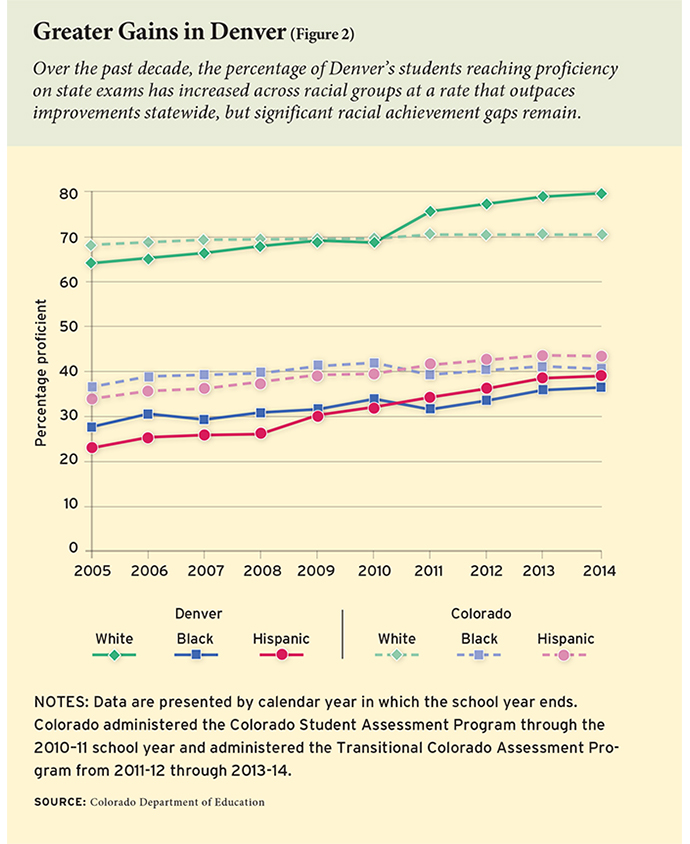
DPS has more than doubled the number of students taking and passing Advanced Placement courses, and African American students now take advanced math classes at the same rate as whites, while Hispanics lag only 1 percentage point behind. Only 48 percent of DPS graduates enrolled in college in 2014, but 1 in 7 low-income students in Denver did so compared to 1 in 20 in the rest of the state.
On the other hand, Denver’s steady improvement has widened the achievement gap, something that happens in many urban districts that improve, as white and middle-class students raise their scores faster than poor and minority students. In 2014, the gap between the percentage of low-income and non-low-income students who tested at grade level was almost 40 points across all subjects, and the gap between African Americans and Latinos, on the one hand, and whites, on the other, was 42 points.
Charter Schools Lead the Way
Because Denver’s two largest and most successful charter networks, DSST and STRIVE Prep, started with high schools and middle schools, respectively, the city’s charters are unusually concentrated at the secondary level. And though DPS has clearly improved its elementary schools, at the secondary level charters account for almost all the academic growth. In a 2014 study published by the Donnell-Kay Foundation, which used SPF data through 2013, author Alexander Ooms concluded,
“The decision to close poorly-performing schools of all types appears to be paying dividends and is especially encouraging for low-income students. Likewise the decision to encourage replication of the best charter schools has clearly led to positive results. But the district’s attempts to open its own new schools, and particularly to improve its continuing schools serving secondary grades, have yielded remarkably little.”
A year later, an analysis of 2014 SPF scores revealed little change. Six of the top eight schools were charters. And though only 25 percent of DPS schools are charters, they account for 40 percent of the most sought-after schools for Kindergarten, 6th grade, and 9th grade. Of the 30 schools on the top-ten lists for these transition grades, 12 are charter schools.
A study of test scores from 2010 through 2014, by economists at the Massachusetts Institute of Technology and Duke University, found that Denver’s charters produced “remarkably large gains in math,” large gains in writing, and smaller but statistically significant gains in reading, compared to DPS-operated schools. The gains in math were the equivalent of closing almost half the yawning gap between white and black students in the U.S.
Do charters perform better because they attract better students? They do have advantages: 100 percent of their families make an active choice to enroll; their students arrive with slightly higher test scores; and they don’t have to accept new students after the school year begins. On the other hand, charters get 19 percent less money per student than district-operated schools, according to one analysis. Though the district strives for equity, charter teachers are not eligible for ProComp bonuses, which average $7,396 for a second-year teacher. Nor do most Denver charters get district-funded transportation for students.
Charters’ success does not appear to stem from an easier mix of students. Charters enroll almost as high a percentage of special education students as DPS-operated schools do—10 vs. 11 percent. But charters serve 3 percentage points more low-income students (those who qualify for free and reduced-price lunch) and 10 percentage points more English language learners.
Perhaps the most reasonable way to compare charters and DPS-operated schools is to analyze school test scores and percentages of low-income students together, on the same scatter plot. Using 2015 test-score data and comparing schools with similar percentages of low-income kids, charters outperform DPS-operated schools at the middle and high school level but not at the elementary level, where there are only 10 charters.
Innovation Schools Struggle for Autonomy
One of Michael Bennet’s first moves, back in 2005, was to recruit Brad Jupp, a union leader who had helped negotiate performance pay, to be his senior policy advisor. A former teacher, Jupp was convinced that DPS principals needed more autonomy to improve their schools. In the fall of 2006, he and Bennet decided to create something like Boston’s Pilot Schools—in-district “Beacon Schools.” They negotiated a memo of understanding with the teachers union, then asked teachers and principals to make proposals. We offered “greater resources, the opportunity to have a new school design, and a bit of autonomy,” Jupp says. Their offer generated considerable excitement and 24 proposals.
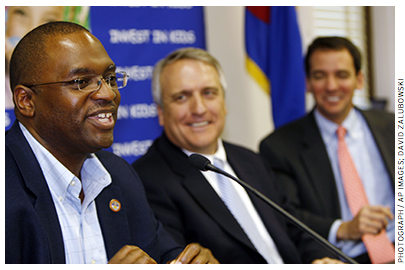
But Beacon Schools quickly bumped into the limits imposed by the district and the teachers’ contract. Frustrated leaders at one school proposed a novel use of a waiver clause in the contract, to waive everything but the provisions that permitted union membership and representation. The board approved the waiver—plus two more, for other schools.
State Senate president Peter Groff, from northeast Denver, seized on the idea, and with help from Bennet’s staff and other reformers, drafted a statewide Innovation Schools Act. Passed in 2008, it invited proposals for creating innovation schools, which could request waivers to district policies, state statutes, and union contracts—including tenure for new teachers—if 60 percent of the teachers voted for the Innovation Plan.
In the early years, the district rushed innovation schools into place without much attention to their design. Not surprisingly, the results were disappointing. But for the past few years, DPS has treated the innovation school authorization process much like the charter authorization process, and new innovation schools have looked far more like charters—with a year to plan, clear visions and strategies, and careful hiring of teachers.
Some innovation schools have made remarkable progress, but as a group, they have not performed nearly as well as charter schools on standardized tests, according to two separate studies. Kelly Kovacic, the DPS executive director of portfolio management, acknowledges that innovation schools have not bent the curve on performance.
Three important differences between innovation schools and charters may contribute to their different success rates. First, charters are often closed if they fail to meet their performance targets. So far no failing innovation school has been closed. The board adopted a policy last December, however, to apply exactly the same standards and process to closing all schools—charter, traditional, and innovation.
Second, successful charters usually replicate, while innovation schools have yet to do so. That, too, is about to change: two successful innovation schools will open new campuses next fall. Unless they fall flat, Boasberg told me, he intends to continue the practice.
Third, innovation schools have more autonomy from district mandates than traditional DPS schools but far less than charters. Some of the innovation school principals I interviewed were happy with the degree of autonomy they enjoyed, but others were quite frustrated. In part, it depended on whom they dealt with at the district level: their instructional superintendent, their HR partner, their budget partner, and so on.
“It’s infuriating to innovation school principals, because they feel like they have the blessing of the top leadership, but it’s like cutting through frozen molasses,” says Alan Gottlieb, who has been following education in Denver for more than 20 years, as a journalist, a foundation executive, and the founder of an online education magazine. “Any little thing—hiring somebody, getting a school bus, ordering new furniture—it’s all impossible. And it is because everybody below the top level is operating as though they’re still just working for a traditional school district.”
The issue is not so much outright restrictions as the constant bureaucratic battles principals must endure. Zach Rahn, who runs Ashley Elementary, offers the example of a district initiative to create teacher leaders, who teach half time and coach other teachers half time. It has been an “unbelievably huge benefit to our school communities,” he says. “But now as they seek to bring it to the whole district, they’ve put all these strings attached to it that actually take away from it. They sent us a 42-slide PowerPoint on how we need to organize the ecosystem in our school.” It included a rubric to rate the school’s readiness, a survey to fill out, and essays to write on why the teachers they chose were the most qualified—though Ashley was already using teacher leaders.
Rahn and some of his peers routinely ignore such mandates, then have to waste precious hours fighting the resulting battles. The time they lose troubles him, Rahn says, but “I also think about my colleagues around the district, who are just as capable as I am, and they aren’t getting that option” to refuse.
This is the biggest reason innovation schools have not performed as well as charters, he believes. “Hold me accountable to whatever levels you want, but I need to be able to lead, and do my job, and not be stuck in the weeds down here.”
Rahn and three other innovation school principals proposed the Innovation Zone. In December 2015, the Board of Education endorsed the idea, though details are still being worked out. If done well, this initiative could be a real breakthrough, giving some innovation schools the same autonomy that charters enjoy, along with a board to shield them from district mandates and politics.
The struggle over autonomy is part of an overall lack of alignment within the DPS bureaucracy. The district has had a “strategic plan” since 2005, now called The Denver Plan 2020. But it is primarily a set of goals, with less emphasis on strategies. Because they did not want to give the opposition a big target, Bennet, Boasberg, and their allies on the board chose never to use the phrase “portfolio strategy” and never to broadcast their intention to increase the number of charter schools.
This silence has been successful, politically. In contrast, when Newark superintendent Cami Anderson presented her strategies in her “One Newark” plan, it gave her opponents a big, fat target, and she was gone within two years. But the price of Denver’s success has been frustration on the part of principals, who have to deal with central office staffers who don’t all share Boasberg’s vision.
The lack of alignment has also led to inconsistencies in hiring central office and school leaders. Finding leaders who can turn around schools full of low-income kids is usually the toughest challenge, and in Denver those making the choices have not always been on the same page. If DPS leaders more clearly articulated their overall strategies, their employees might better understand their priorities.
Is Denver’s Strategy Sustainable?
Boasberg and the board deserve credit for putting in place many of the elements of a portfolio strategy. They have embraced charter schools and learned a great deal from their success, bringing many charter practices into district schools. The SchoolChoice enrollment process has increased access to good schools and made it more difficult for schools to cream the best students. The district is moving more special-education centers for extremely disabled students into charters, correcting an imbalance.
DPS staff are also working to fix the SPF’s big flaw, its overreliance on academic growth. Since the Colorado Growth Model compares students only to those who had similar test scores in the past, a student can show “high growth” by gaining five months of learning a year if the comparison group is only gaining four months. So schools can look successful, even while their students are falling further behind grade level every year. In the future, growth will only outweigh proficiency by 3:2 at the elementary level, though the ratio will remain 2:1 at the secondary level.
Boasberg is on a six-month sabbatical, but when he returns in the summer of 2016, he is likely to enjoy support from a majority of the board for quite a few years. The opposition is weak and disorganized, and all the momentum is on the side of the reformers. If anything, some on the board are frustrated that Boasberg is not moving faster.
It is hard to see what might derail the portfolio strategy, even if the bureaucracy continues to slow it down. Denver has proven, for a decade now, that charter schools offer a more effective model of urban education. It is about to launch an Innovation Zone, which—if done properly—will give some district schools the autonomy and accountability that make charters so effective.
Within a decade, the district could reach a tipping point, where a majority of public school families choose charters or innovation schools. When that happens, the reforms will be difficult to undo. And Denver will be well on the road to proving that an elected board can transform a 20th-century system organized on the principles of bureaucracy into a 21st-century system built to deliver continuous improvement.
David Osborne, co-author of Reinventing Government and other books on public sector reform, is director of the project on Reinventing America’s Schools at the Progressive Policy Institute. A longer treatment of this subject will be available at www.ppionline.org.
This article appeared in the Summer 2016 issue of Education Next. Suggested citation format:
Osborne, D. (2016). Denver Expands Choice and Charters: Elected school board employs portfolio strategy to lift achievement. Education Next, 16(3), 34-43.


